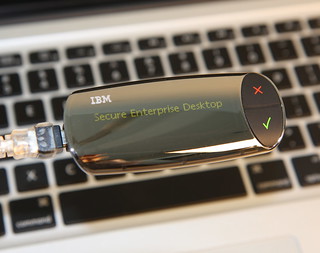 |
| IBM scientist Michael Baentsch |
Michael: First of all, there’s a clear need for such a technology, particularly around the trend of Bring Your Own Device. What's more, PCs have become a commodity so, with the Secure Enterprise Desktop, we are supporting this trend by making it move forward even faster.
Paolo: We started out by improving an existing technology that didn’t offer the security or mobility features required by many businesses and companies, especially banks, for example, which obviously have extremely high security needs. Simply put, we redesigned the existing technology and incorporated the security of the ZTIC technology.
 |
| IBM scientist Paolo Scotton |
Michael: Most of the basic work had already gone into developing the two component technologies of OS streaming and ZTIC. So the biggest remaining challenge was to accommodate the wide range of technical standards applicable to this kind of solution.
Paolo: The new streaming technique we developed really enhances the end user’s experience. With our Secure Enterprise Desktop, a Windows desktop is typically available in about 2 minutes, starting from an empty machine, and that’s a groundbreaking result because it provides true mobility.
Q. That sounds very impressive. When can I get it?
Michael: That’s exactly how several clients we have talked to are reacting. Many of them recognize its significant merits and want it as soon as possible.
During the development of the ZTIC we established an extensive network of contacts and have given countless demonstrations to CIOs of numerous companies. We tapped that network to introduce the Secure Enterprise Desktop, and clients are responding enthusiastically. Virtually every major company has a growing need for computational mobility and enhanced security.
Q. So you're telling me that, with this lightweight little Secure Enterprise Desktop stick, I won't need to schlepp my laptop anymore?
Michael: That's right. Take a typical example of people like you who work partially from home. You could remove the Secure Enterprise Desktop stick from your company PC, leave that machine in the office, pop the device into your handbag, plug it into your home computer and continue to work where you left off. In this case, yes: no more schlepping your laptop.
Paolo: Exactly. Other people might still need or want to carry their laptop, but it could be a much smaller, lighter and especially cheaper machine, possibly owned by the employee. The mobile laptop itself may be of only nominal value. And because it wouldn’t provide access to valuable corporate data, it would be much less attractive for theft, for example.
Q. The IBM BlueZ Business Computing team at the Zurich Lab has achieved more than a decade of successes with smartcard chip software, including ZTIC and now the Secure Enterprise Desktop. What do you attribute this string of success to?
Michael: In three words, to use Peter Drucker’s famous expression: “Serving customers profitably”.
We have matched our team’s capabilities with current market needs and have validated the initial concepts by means of customer discussions and first prototype validation. If we then see the proverbial spark of interest to buy in a customer’s eyes, we proceed full speed to create a valuable and innovative solution.
Side note: The author of this article has signed up to be a pilot user and will be blogging about her experience in the near future.


What does "schlepping" mean ??
ReplyDelete"Haul or carry (something heavy or awkward)."
ReplyDeleteIt comes from Yiddish
ReplyDeleteits also German schleppen means to carry or to lug something around
ReplyDeleteThanks for the Translations. My laptop is a W510 so I know exactly how unpleasant lugging a heavy laptop is :-)
ReplyDelete